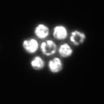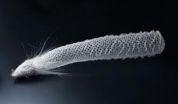INFORMATION:
Monika A. Kusiak et al.: "Metallic lead nanospheres discovered in ancient zircons", Proceedings of the National Academy of Sciences, PNAS Early Edition, 06.04.2015, DOI: doi/10.1073/pnas.1415264112
A poto in a printable resolution may be found here:
https://media.gfz-potsdam.de/gfz/wv/05_Medien_Kommunikation/Bildarchiv/Einzelbilder_Neuestes/Pb%20Kugel%20in%20Zirkon.jpg
caption:
Zircon from East Antarctica with nanospheres of metallic lead under GFZ's transmissionelectron-microscope TEM. The rock sample is more than 3,4 billion years old. Photo: GFZ
Lead hokes the age
2015-04-06
(Press-News.org) 06.04.2015: Rocks do not loose their memory during Earth history but their true ages might be distorted: even under ultra high-temperature metamorphic conditions exceeding 1200°C zircon maintains its lead content accumulated during radioactive decay of uranium and thorium.
Giga year old zircon crystals still contain lead in form of nanometre size spheres of pure lead. However, the inhomogeneous spatial distribution of the lead spheres might falsify ages determined from high-resolution Pb isotope measurement with ion probe.
Zircon is an ideal mineral for age determination of very old rocks because it is believed to be a closed system during Earth history. Zircon geochronology thus is a standard method of geological age determination. Recently, an international group of earth scientists studied zircon from 3,4 billion years old high-temperature metamorphic rocks from Antarctica with transmission electron microscopy TEM at the GFZ German Research Centre for Geosciences. TEM investigations revealed that the lead from radioactive decay was not homogeneously distributed in zircon but was accumulated withinin inhomogeneously distributed Pb nano-spheres in zircon with only 5 to 30 nm in diameter. The inhomogeneous distribution of lead in zircon might adulterate the ages measured with high-spatial resolution ion probe technique.
ELSE PRESS RELEASES FROM THIS DATE:
Under the microscope, strong-swimming swamp bacteria spontaneously organize into crystals
2015-04-06
Insects form swarms, fish school, birds flock together. Likewise, one species of bacteria forms dynamic, living crystals, says new research from Rockefeller University. Biophysicists have revealed that fast-swimming, sulfur-eating microbes known as Thiovulum majus can organize themselves into a two-dimensional lattice composed of rotating cells, the first known example of bacteria spontaneously forming such a pattern.
"The regular, repeated arrangement of the microbial cells shares the geometry of atoms within a mineral crystal, but the dynamics are fundamentally different; ...
Study suggests new role for gene in suppressing cancer
2015-04-06
Scientists at The University of Manchester have discovered that a previously known gene also helps cells divide normally and that its absence can cause tumours.
The glucocorticoid receptor (GR) has previously been shown to have a role in cell development, immune response and metabolism. It is found in almost every cell in the body. Many widely used drugs, including prednisolone, act through this protein.
The research from Manchester, to be published in the journal Proceedings of the National Academy of Sciences (PNAS), showed a new role for GR after the scientists ...
Neighborhood stigma affects online transactions, NYU researchers find
2015-04-06
The stigma associated with particular neighborhoods has a direct impact on economic transactions, a team of New York University sociologists has found.
Their study, which appears in the journal Proceedings of the National Academy of Sciences, shows that when sellers are seen as being from an economically disadvantaged neighborhood, they receive fewer responses to advertisements placed in online marketplaces.
"Advertisements identifying the seller as a resident of a lower-income neighborhood received significantly fewer responses than advertisements identifying the ...
Sea sponge anchors are natural models of strength
2015-04-06
PROVIDENCE, R.I. [Brown University] -- Life may seem precarious for the sea sponge known as Venus' flower basket. Tiny, hair-like appendages made essentially of glass are all that hold the creatures to their seafloor homes. But fear not for these creatures of the deep. Those tiny lifelines, called basalia spicules, are fine-tuned for strength, according to new research led by Brown University engineers.
In a paper published in the Proceedings of the National Academy of Sciences, the researchers show that the secret to spicules' strength lies in their remarkable internal ...
Study: Near-death brain signaling accelerates demise of the heart
2015-04-06
ANN ARBOR, Mich. - What happens in the moments just before death is widely believed to be a slowdown of the body's systems as the heart stops beating and blood flow ends.
But a new laboratory study by the University of Michigan Medical School reveals a storm of brain activity that erupts as the heart deteriorates and plays a surprising destabilizing role in heart function.
This near-death brain signaling may be targeted to help cardiac arrest patients survive. Most of the more than 400,000 Americans who experience cardiac arrest at home, at work or in public die without ...
Study reveals Internet-style 'local area networks' in cerebral cortex of rats
2015-04-06
Researchers sketching out a wiring diagram for rat brains -- a field known as "connectomics" -- have discovered that its structure is organized like the Internet.
For years, scientists looking for clues to brain function through its structure focused on what could be seen -- the brain's lobes, grooves and folds. Now, with a more comprehensive picture of how neurons connect to one another, they've discovered local networks of neurons nested into one another like shells.
"The cerebral cortex is like a mini-Internet," said Larry Swanson, professor at the USC Dornsife College ...
NIH-funded scientists identify receptor for asthma-associated virus
2015-04-06
Scientists funded by the National Institute of Allergy and Infectious Diseases (NIAID), part of the National Institutes of Health, have identified a cellular receptor for rhinovirus C, a cold-causing virus that is strongly associated with severe asthma attacks. A variant in the gene for this receptor previously had been linked to asthma in genetic studies, but the potential role of the receptor, called CDHR3, in asthma was unknown. The new findings help clarify the function of CDHR3 and point to a novel target for the development of prevention and treatment strategies against ...
Computers that mimic the function of the brain
2015-04-06
Researchers are always searching for improved technologies, but the most efficient computer possible already exists. It can learn and adapt without needing to be programmed or updated. It has nearly limitless memory, is difficult to crash, and works at extremely fast speeds. It's not a Mac or a PC; it's the human brain. And scientists around the world want to mimic its abilities.
Both academic and industrial laboratories are working to develop computers that operate more like the human brain. Instead of operating like a conventional, digital system, these new devices ...
Breastfeeding women and sex: Higher sex drive or relationship management?
2015-04-06
New mothers in the Philippines spend more time in the bedroom with their partner in the first few weeks after giving birth than they did before they became pregnant. This might be a type of survival strategy to keep the relationships with the fathers of their new babies alive and well, to ensure continued support for their offspring. So says Michelle Escasa-Dorne of the University of Colorado in the US, after studying how women from a society with a low divorce rate such as the Philippines adapt to being both mothers and lovers. The study appears in Springer's journal Human ...
Common antidepressant increased coronary atherosclerosis in animal model
2015-04-06
WINSTON-SALEM, N.C. - April 6, 2015 - A commonly prescribed antidepressant caused up to a six-fold increase in atherosclerosis plaque in the coronary arteries of non-human primates, according to a study by researchers at Wake Forest Baptist Medical Center. Coronary artery atherosclerosis is the primary cause of heart attacks.
The study is published in the current online issue of the journal Psychosomatic Medicine.
"The medical community has known for years that depression is closely associated with heart disease, but we didn't know if treating it would reduce the heart ...

